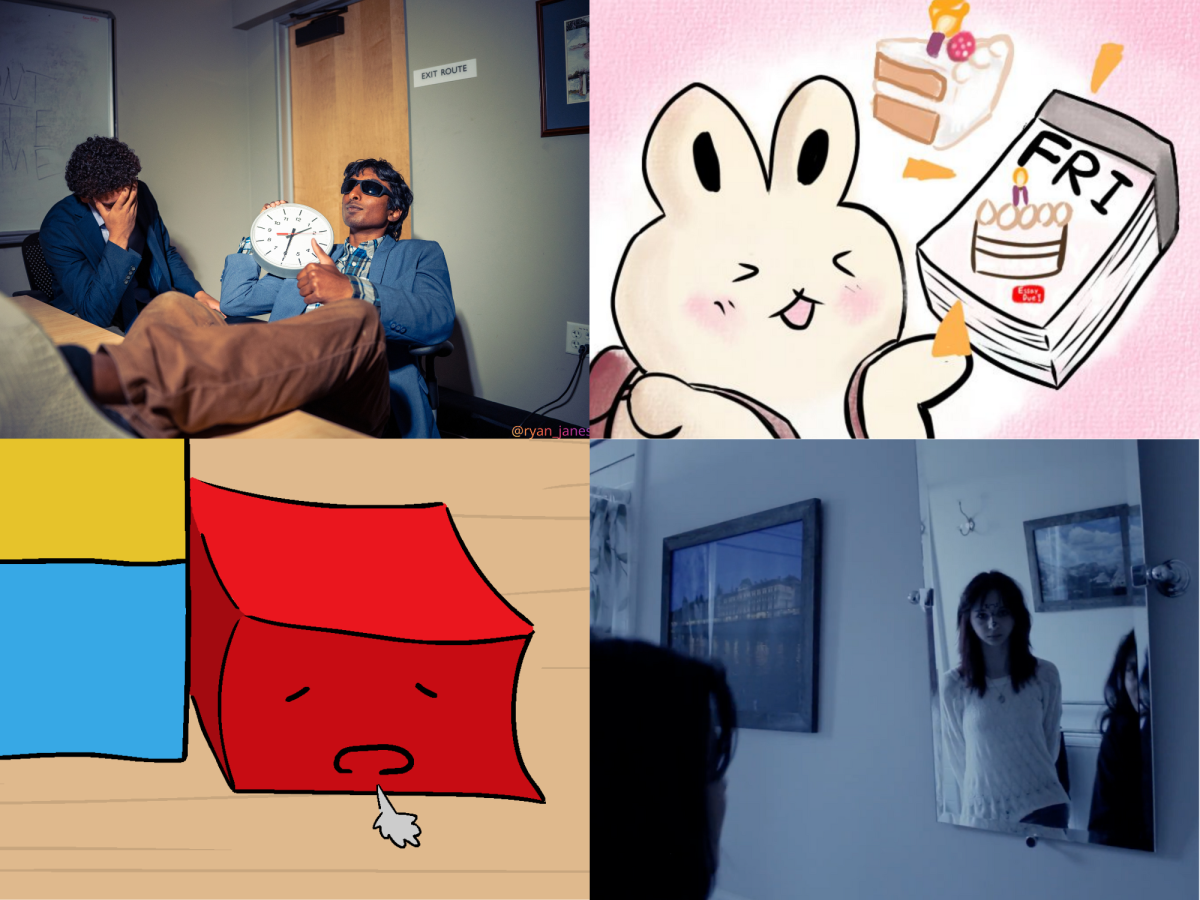The manner in which the media portrays body image, particularly for leading women and models, creates the idea that to be beautiful and loved by the man or woman of your dreams, you must be a size zero. Shows like the hit reality show “America’s Next Top Model” make rail-thin girls the norm and plus-size girls who would be considered a normal weight by health standards the out-of-place ones who must “overcome” the obstacle that is their weight.
Another television show, “The Biggest Loser,” also contributes to society’s distorted view of obesity. For the past 15 seasons, audiences have watched in enthralled horror as overweight individuals compete to win a cash prize by losing the highest percentage of weight relative to their original weight.
Watching overweight people on TV trying their hardest to lose weight is not entertainment. Portraying obese individuals on TV in this fashion only contributes to this view that obesity is something to be mocked, and makes the individual viewing the show feel better about themselves at the expense of others.
This is likewise true of the portrayal of overweight people in media. Rarely do overweight people end up as part of the cast in a group filled with thin people. If they are a part of such a cast, often they end up as the punchline of an endless parade of fat jokes and seem unable to separate themselves from their weight. Even when overweight characters have leading roles in a TV series, their size continues to be the focus of the show. “The Mindy Project” and “Super Fun Night” both suffer from this affliction, though the shows are written by the leading, plus-size ladies of both respective shows.
The media attempts to combat body image issues through public service announcements about loving one’s body. However, sometimes these methods for combating serious health problems like anorexia and bulimia can end up feeling like nothing but hollow attempts meant to ease the guilt of network and film executives.
TV shows like “Glee” are notorious for handling issues like anorexia irresponsibly. In the case of Glee, the producers of the show “gave” its already model-thin character Marley anorexia. The show used the eating disorder to stimulate its plot, and then discarded the disorder after a few episodes. Marley was seemingly given an eating disorder for the dual purpose of creating a ridiculous love triangle and having the glee club lose their sectionals competition.
With the media treating eating disorders as a temporary affliction that can be cured with a stern lecture and an “I promise never to do it again,” the target audience of adolescent girls gets the wrong idea of the true consequences of such a disease.
The media also contributes to a distorted view of the male body. Shows like the C.W.’s “Supernatural” and MTV’s “Teen Wolf” star buff, strong male individuals. The media idolizes a specific male image, the emotionless buff male. This further perpetuates gender roles, and gives young boys the idea that this is what they must look and act like to be considered normal.
Sexuality
As American society moves towards what is typically considered a more liberal perspective, media representation of different sexualities has become more frequent. However, portrayal of the Lesbian, Gay, Bisexual and Transgender community is not always fair or accurate.
Shows like Will and Grace, Glee and Modern Family have paved the way in attempting to create acceptance for LGBT characters. However, the cookie-cutter, stereotypical depiction of their LGBT characters on those shows and more recent ones like The New Normal and Sean Saves the World aren’t entirely synonymous with the reality.
For example, the media often sexualizes lesbians, and creating a fetish out of a sexuality. The 2003 MTV Video Music Awards is most remembered for the kiss shared between Britney Spears and Madonna. In 2008, one of the most talked about songs of the year was Katy Perry’s breakout hit I Kissed a Girl. Media like this portrays being lesbian as a fad, something that is sexy and attractive, rather than an actual sexuality that many identify with.
Bisexuality is also portrayed by the media as not a legitimate descriptor. Audiences will be hard pressed to find a character who is acknowledged as bisexual and not as someone “experimenting” or who is confused. Shows and movies will often joke that bisexual characters simply went through an experimental phase.
Even worse is the representation, or lack thereof, of transgender people in media. Many shows simply do not even discuss this important group. However, some shows do seem to be attempting to mitigate stereotypes surrounding this group. Glee’s character of Unique, where the transexual character is attempted to be portrayed in a positive light. 1999’s Boys Don’t Cry starring Hilary Swank as a transgender male did try to seriously discuss the stigma and violence that comes with misunderstanding those who are transgendered.
Despite such attempts, transgender characters often end up being built up for laughs. It is common to find in typical comedies, especially the older ones, a scene where one of the characters hits on someone they assume to be a certain gender and are later surprised – and, more often than not, repulsed – to find they are a different gender.
Though media is pushing for more LGBT representation – NBC has recently confirmed it is currently developing a lesbian comedy from Ellen DeGeneres – the media still has a long way to go towards acceptance and accurate portrayal of the LGBT community.
– Economics –
For decades the entertainment industry has been characterized by not only high profile stars and productions, but also by the infamously outrageous budgets. From classic box office flops like Waterworld (1995) to modern blockbusters like The Avengers (2012), the industry is risky, expensive and wildly unpredictable. We will look in depth not only at the past and present of Hollywood economics, but the future directions this industry is moving towards.
The entertainment industry manifests itself in many aspects; this article focuses on three: films, television shows and video games. To properly explore the economic changes in Hollywood and around the world, each product will be explored over its entire timeline independently.
First commercially available in the mid-1920’s, the television was an established medium for conveying information to the public, better than the radio. The television set brought entertainment to viewers without the need to buy tickets for the cinema, and promptly grew popular—according to Parents Television Council, in 1949 only around two percent of households in the United States had television sets. Only six years later, in 1955, 64 percent of homes had at least one television, a dramatic increase. A study later in 2007 continued to show this exponential growth finding that more than 98 percent of households had TV’s, a higher proportion than that of those with telephones.
The television industry pays actors large amounts of money for their characters and the views that they bring in. The first regularly scheduled color television show was aired by CBS on June 27, 1951, called “The World Is Yours,” opening the doors to a lucrative but selective industry. Over the following years behind each successful and failed television show there were interesting figures, like the salary and cost of making the show. These figures have drastically increased over the recent years; Charlie Sheen got paid 2 million dollars per episode of “Two and a Half Men,” and the entire cast of “Friends” got paid 1 million dollars each per episode in the final season. These numbers are far greater when compared to Clark Gable, The King of Hollywood, in the 1930s, who made only 4,000 dollars a week from MGM studios.
This same sizable cost is being spread to the movie industry as well. Keanu Reeves was paid more than $150 million to star in both “The Matrix Reloaded” and “The Matrix Revolutions.” His role brought in a gross amount of over $1 billion dollars, a seemingly considerable number when taking into account that movies cost around $300 million to produce. In contrast, 1950s famous film star Marilyn Monroe made $100,000 (inflation adjusted) for four films over seven years. Salaries have continued to soar in the recent years as actors constantly seem to outdo each other getting bigger and bigger contracts.
Video Games
From movies and television shows, viewers wanted a more interactive format to get into the action, the video game. The first video games created on the TX-0, one of the first computers, at Massachusetts Institute of Technology were called Mouse in the Maze and Tic-Tac-Toe, featuring dots and symbols as well as a light pen, a way for the user to interact with the program while it was running. These games were the basis for later games like Pong and from there to the Gamecube, Playstation, Xbox consoles. There are also games like Xbox Kinect and Wii that force you to do the movement and control the display with your body and not a controller. Now, companies like Microsoft are building consoles with not only gaming capabilities but also with the capability for television service, internet connection and home telephone use.
Video games are played by 97 percent of teens ages 12 to 17 whether it be computer, web or handheld. They have become no longer an alternative game to play but rather the only thing to play, leaving games outdoors more and more a thing of the past.
The cost of video games has gotten increasingly higher. The best selling video game ever, Wii Sports sold 82.9 million copies followed by Super Mario Bros, selling 40.24 million copies. Not only are video games becoming more popular, they are becoming more expensive for the consumer as well. The cost of Wii Sports was 20 dollars, which released in 2006, compared to the $59.99 price tag on Grant Theft Auto V, 2013. This shows the immense growth in the economics of the industry and it is no wonder that GTA V expects a profit of 2.2 billion dollars. Video games have grown in cost as well as production and will continue until the consumer decides it has gone too far.
Future
Television/Movies
Television is radically changing in today’s online-viewing world. The emergence of web series as a sustainable and profitable model is the most notable transition in the industry.
Online viewing traffic through services like Netflix and Hulu is rapidly increasing—by the end of September 2013, Netflix surpassed Home Box Office (HBO) in subscribers in the United States. Traditionally, consumers have been drawn to such streaming websites because they offer the freedom to view at their leisure as well as the ability to watch entire seasons without waiting the painful week in between each episode on television.
“While our original series get most of the headlines, a bigger percentage of overall Netflix viewing is generated by our exclusive complete season-after series,” Netflix CEO Reed Hastings said in October’s shareholder report.
While television shows are still the staple of online streaming services—namely Netflix, Hulu and Amazon Prime—these companies are increasingly diversifying their options to consumers by providing exclusive web series. Shows like “House of Cards” and “Orange is the New Black” define the emerging trend of web series by airing only on Netflix, an offer which sweetens the already lucrative monthly subscription online.
Amazon Prime’s Instant Video service, the retail giant’s competitive counter to Netflix, just announced plans to release five new web series based on user preference data. In addition to confirming the endurance of web series on streaming services, this development reveals two notable characteristics of this competitive market.
First, no streaming company can ensure that their customers stay without providing their own content. Netflix and Hulu will lose a large portion of their subscribers if rivals like Amazon Prime match their standard lineup while also providing new content, and potential competitors won’t stand a chance if they merely match the television based lineups of the past. Whichever service can provide the best shows gets the consumers.
Second, preference is paramount and diverse. The number of shows on Netflix is massive—but people are still willing to watch new shows that differ from the existing ones. Web series on YouTube have exploded because everyone has a unique preference. The only way for companies to provide the most popular content is to look at the numbers.
Amazon narrowed down their final five shows to bring into production (from 14 pilots) based not on taste or analyst opinion but data. As the base of viewers increases, streaming providers must use data more efficiently, or else run the risk of losing their beloved subscribers. Tailoring shows to their viewers is the future of web series, and by being the first to properly utilize the massive numbers of user data, Amazon is poised to take an early lead.
The future of web-exclusive content is uncertain, but irrespective of the path these shows take, consumers will benefit. Shows will target viewers, providing episodes that people are genuinely interested in, and vicious competition between web providers over their exclusive content will likely improve their equality across the board. Web series are the future of television—and every trend suggests that they will only get better.
Video Games
Video games are famous for their rapid evolutions, and as the youngest genre in entertainment (by a large margin) gaming is also the most prone to experimentation. Now, two new ideas are revolutionizing the video game industry – free to play games and online distribution. Between these two changes, the face of the gaming world may change forever.
Rockstar’s latest hit, Grand Theft Auto V, released to incredible reviews and enormous commercial success – the game grossed over one billion dollars in under 72 hours, the fastest rise to one billion dollars in the history of entertainment. While the title broke dozens of records for sales, entertainment industry experts also scrutinized the astronomical development costs, which rumors placed at around 260 to 300 million dollars. In contrast, League of Legends – the insanely popular multiplayer game affectionately known as LOL – is free to play in its most perfect form. In-game purchases are possible, but these custom skins serve only as cosmetic accessories and don’t upset the intricate balance between each playable character. Other multiplayer titles, like Valve’s Defense of the Ancients (DOTA) 2 and Team Fortress 2, similarly include purchases which change only the appearance of the character. Unlike ‘freemium’ games – in which in-game purchases are either required to progress or all but mandatory to remain competitive – these titles offer the pure, sacred free-to-play style gamers dream about.
A decade ago, this model would seem impossible. The volume of gamers willing to purchase such superficial upgrades simply wasn’t enough to compensate for development costs. With the advent of multiplayer games and a massive increase in gamers, however, these in-game purchases have become more common. The free-to-play model is also no longer limited to PC’s, where it truly took off in popularity. At the 2013 E3 Conference, both Microsoft and Sony lent their floor space to free-to-play developers, allowing them to showcase what may be the future of both console and PC gaming. And as for the gamers – well, who wouldn’t want free to play games?
The next generation of consoles is coming, and with the Xbox One and Playstation 4 on the way gamers are finally able to picture what the next evolution of console based gaming will look like. Hardware improvements and software interfaces aside, one major change is set to impact the economic landscape of gaming – online distribution.
The used game industry is gigantic – in 2012 spending on used games amounted to 1.6 billion dollars, according to gamesindustry international. Consumers rely on reduced game prices to afford new titles or get back some of their hefty initial investments. Digital purchases threaten the often underestimated value in physical copies.
While both Sony and Microsoft have had digital stores on their respective consoles for years (the Xbox Game Store launched in November 2005), all coverage surrounding the new console generation suggests an increased focus on digital distribution. The benefit of such a system is primarily convenience. Gamers don’t have to organize their discs, or go searching for their favorite titles. Everything is put together in a cohesive, comprehensive manner. Distributing costs will also be lower for developers, which could prompt a drop in new game titles.
The downside is the loss of all benefits related to hard copy games. Lending to friends, buying and selling used copies, and taking pride in your own collection – the future of gaming is at risk of losing those experiences. The transition from physical to digital games will not occur overnight, but the change has already started – and in the coming years gaming may end up without wallside shelves or green and gray game cases, but instead hard drives and cloud storage. The video game industry is relatively new, and as it grows the developments will likely be sudden and often. Gamers will be the ones to benefit.







